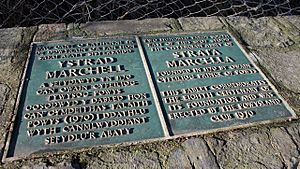Strata Marcella facts for kids
Quick facts for kids Strata Marcella Abbey |
|
|---|---|

Commemoration of eighth century of Abbey's foundation
|
|
| Religion | |
| Affiliation | Catholicism, Cistercians |
| Ecclesiastical or organizational status | Ruin. Abbey dissolved 1536, stone sold to build local churches. |
| Year consecrated | 1170 |
| Location | |
| Location | Near Welshpool, Powys, Wales |
| Architecture | |
| Architectural type | Monastery |
| Architectural style | Cistercian |
| Specifications | |
| Length | 273 feet |
| Width | 96 feet |
The Abbey of Strata Marcella (Welsh: Abaty Ystrad Marchell) was a monastery in Wales. It was home to Cistercian monks during the Middle Ages. The abbey was located on the west bank of the River Severn, close to Welshpool in Powys. Its name, Strata Marcella, is the Latin version of the Welsh name, Ystrad Marchell.
Contents
Building the Abbey
The Strata Marcella Abbey was founded in 1170. It was started by Owain Cyfeiliog, who was a Prince of Powys. The abbey was dedicated to the Virgin Mary. It was a "daughter house" of the Abbey at Whitland. This means it was an offshoot or new monastery started from an older one.
Within two years, the abbey moved a short distance to its current location. At first, the buildings were likely made of wood. Stone construction began around 1190. Building continued until the early 1200s. Strata Marcella grew to be the largest Cistercian Abbey in Wales. Its main hall, called the nave, was 200 feet long. Some monks from Strata Marcella later went on to found Valle Crucis Abbey in 1200.
Abbey and Welsh Rulers
Owain Cyfeiliog retired to the monastery when he was older. He became a Cistercian monk. When he died in 1197, he was buried at the abbey. His son, Gwenwynwyn, then became the abbey's protector. He gave the abbey more land and gifts. This made Strata Marcella a very wealthy and important religious place.
Strata Marcella was one of several Cistercian abbeys in Wales. These abbeys were founded by Welsh princes. They were independent from the Norman-founded abbeys in England. Because of this, they often supported the Welsh princes. They stood with them in their fights against King Edward I of England.
Challenges and Decline
The abbey suffered a lot of damage during the Welsh wars for independence. By the 1300s, it was quite poor. In 1332, a local lord named John de Cherleton accused the monks of working against English rule. He sent all the Welsh monks away to English monasteries. He replaced them with English monks from Buildwas Abbey.
During the Owain Glyndŵr uprising in the early 1400s, the abbey buildings were badly damaged again. The monastery never fully recovered after this.
The End of the Abbey
Strata Marcella Abbey finally closed in 1536. This happened during the dissolution of the monasteries in England and Wales. At that time, its income was very low, and there were only four monks left.
Edward Grey, a local noble, bought the site. He removed everything valuable from the abbey. The stone from the buildings was sold. It was used to build several local churches. Today, only a few stone remains can be seen. They are in a meadow next to the River Severn.
Exploring the Ruins
The site was dug up and studied in 1890 by Stephen W. Williams. He found that the church was 273 feet long. Its main hall, the nave, was 201 feet long. The church also had a tower that was 30 feet square. The building work took a long time, from about 1190 to the early 1300s.
Archaeologists found beautiful stone carvings and tiles from the 1200s. These items are now kept at the Powysland Museum in Welshpool. More recently, the site has been surveyed again. This new work has helped us learn even more about Strata Marcella.

